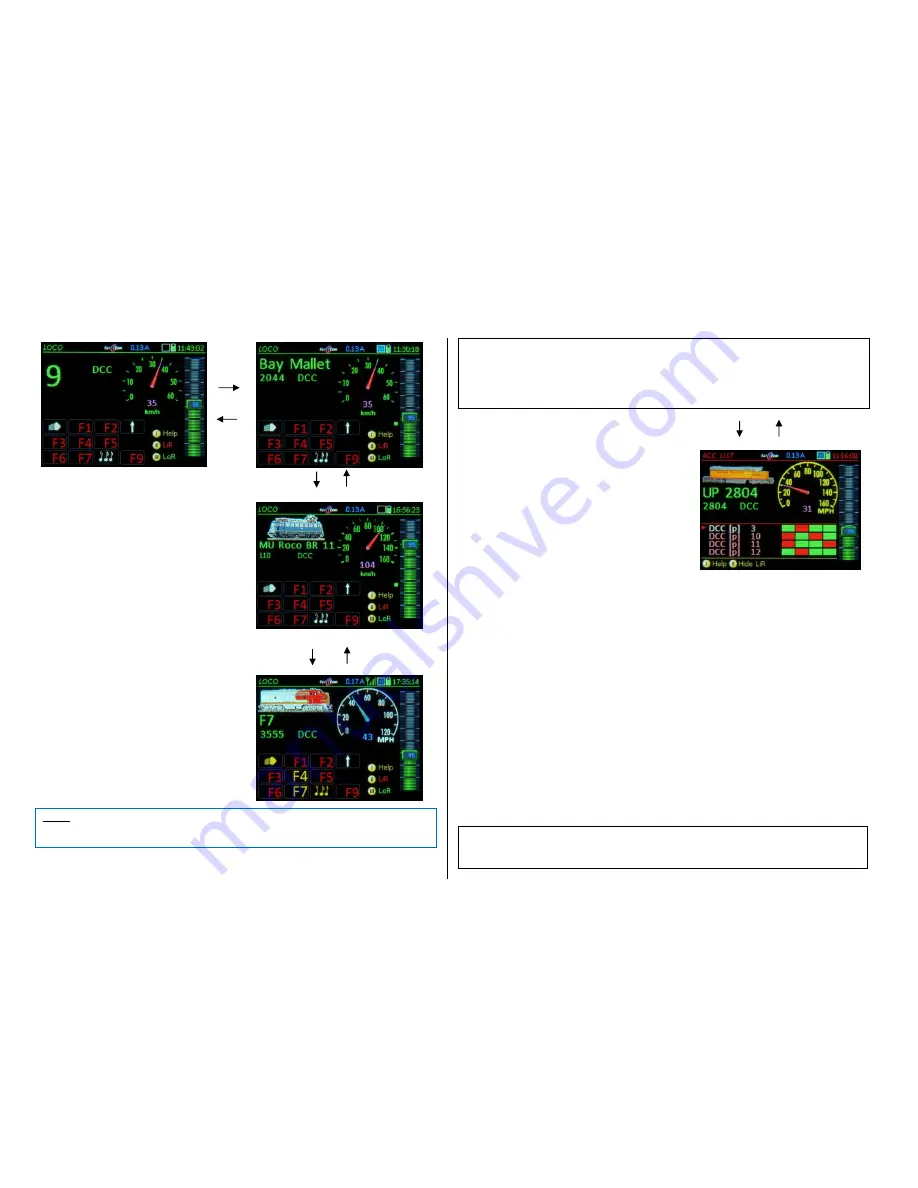
Page 12 TETHERED CONTROLLER MX32, RADIO CONTROLLER MX32FU
U
U
U
F
F
F
Switching between vehicles:
F- Key
or
U- Key
in the
LoR
=
Loco Recall
Scrolls through the loco recall memory forward
or backwards one address at a time. Every ad-
dress is automatically activated as it becomes
visible, which means that there is no need to
close the driving mode
LOCO
during this pro-
cedure.
This works
regardless
of whether
the
LoR
is
dis-
played
(visible) or not.
Deleting locos from the LoR
(recall memory
)
C- Key
Deletes an address from the
LoR
, and
will therefore no longer appear when scrolling
through with the
F-Key
and
U-Key
.
Recovering deleted addresses:
Addresses deleted from the
LoR
remain in the
Object Database
with all their data (especially
the GUI’s).
To restore an address back in the
LoR
, simply
activate it again on the
LOCO IN
page. Enter-
ing the address is all that’s needed since the
GUI settings such as name, group and speed
steps (DCC, MM2…) will be added automatical-
ly from the
Object Database
.
To delete the address permanently from the
Object
Database
,
the corresponding operations mode must
be entered first:
E-Key + 6
Object DB
.
Softkey II
LiR
Opening and closing the ACC
LIST
is an alternate option for activating the accessory
items (switches and signals: it is
address-
oriented
instead of object-oriented.)
W- Key
Object-oriented
mode for
ACC
switching
(see next chapter).
Accessory decoder addresses can be added to the
ACC LIST
and
addresses already there can be ac-
cessed, operated and modified. All addresses as-
signed to the
SWI
panels are automatically added to
the
ACC LIST
and can therefore be operated there as
well. Any MX8, MX9 or StEin modules in the system
will also be listed here automatically and can be op-
erated with the corresponding function keys.
.
To define an
additional address
it is necessary to first scroll down to the line >NEW<; to
edit an
existing address,
it must be marked first with the red cursor (
Scrolling wheel
):
-
A- Key
:
“DCC [e]” (single) is created and can be changed with the rocker switch to:
“DCC [p]” (paired) “MM1 [e]” (Motorola; single)
“DCC [x]” (extended) “MM2 [p]” (Motorola; paired)
-
A- Key
press again to confirm the format and mode (single or paired outputs) and continue to the
address input using the keyboard.
- Press the
A-Key
again to store and activate the accessory decoder address.
Other than that, the keys are used for the following tasks:
Numeric keys
operate the individual turnouts (or single functions)
Scrolling wheel
select a line in the
ACC LIST
C- Key
delete a line in the
ACC LIST
Exit the
ACC LIST
with:
Softkey II
closes the
ACC LIST
and returns to
LOCO
.
(Shift) +
A- Key
LOCO IN
(to enter a new vehicle)
E- Key
E-Screen
With the
ACC LIST
visible in the lower screen half:
U-
/
F- Key
switches between vehicles (within the
LoR
) without leaving the
ACC LIST.
TP- Key
consist functions, same as in the
LOCO
mode (but only if
LoR
is not open).
II
Blue speedo needle
: value for the speed is calculated from speed steps
Magenta speedo needle
:
actual speed feedback from vehicle
The RailCom speedo may need to be adjusted with CV #136 to show the actual speed.
A quick way to calculate and program CV #136 for speedo adjustment is possible with E + 2 keys.
(see chapter
ADDR SPEEDO
).
More information concerning driving, especially about the different representations,
consists, and operating turnouts and signals in the accessory list:
See chapter
LOCO
and
ACC LIST
!
NOTE: to assign a
New Address
of an existing vehicle:
- go to
SERV PROG
:
A- Key
(read-to address), enter new address, confirm with
F- Key
.
-
through “Clone vehicle” (see page 28): clone a vehicle using a new address.



























